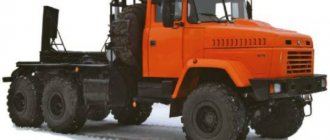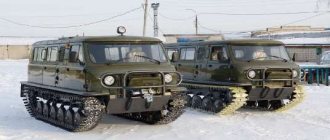GAZ-61
This car model appeared in 1938. The Soviet Union simply needed a vehicle that had greater cross-country ability than the rest. Construction sites, the army and agriculture were in great need of it. The GAZ-61 is all-wheel drive, it exactly met all the requirements that were voiced.
This is what Gas 61 looks like
Motor. It had a volume of 3.48 liters. The power unit had 6 cylinders with valves at the bottom. The carburetor engine produces 76 horsepower. The metal went there - cast iron. The internal combustion engine was quite powerful to go off-road and even pull trailers. Fuel consumed 15 liters when traveling 100 km, at a maximum speed of 107 km/h.
The manual gearbox was installed in 4 stages. The clutch was placed on 1 disc dry.
This is what the Gas 61 engine looks like
The suspension is fully dependent. There are 2 bridges. The front axle was installed at the factory for the first time. The height of the SUV above the road was 210 cm. it was impressive.
- The brakes on the GAZ-61 were drum mechanisms.
- GAZ-61 weighed 2 tons.
- Advantages and disadvantages.
This is what the GAZ-61 suspension looks like
- The car had both features and shortcomings:
- The car was made of excellent metal.
- The internal combustion engine was one of the best at that time.
- The car was very tall and could easily overcome off-road conditions.
- The salon was considered large, roomy and comfortable due to the sofas.
- You could smoke in the car; there was a cigarette lighter for this, and there was also an urn for ashes and extinguished cigarettes.
- The car was all-wheel drive - this is a big plus.
Exterior view of the GAZ-61 interior
- A trailer could be attached to the car.
- The downside is the weight of the machine (heavy).
- There was no hydraulics.
- The safety precautions for the driver and passengers are not taken into account (there is not a single seat belt).
- There is no driver's seat adjustment.
- No stove.
- The wheels were small.
- Many parts were made of iron, which had the ability to freeze in winter.
GAZ-230810 “Ataman-Ermak”, 1999
At the stage of development of the GAZ-2308 “Ataman” model, the designers proposed about 20 modifications, but only two of them reached the stage of producing prototypes. The first of them, GAZ-230810, was called “Ataman-Ermak” and was presented in the form of a five-seater station wagon. A total of 3 copies were created, and the model was first released in 1999.
The second modification of the classic “Ataman” was the GAZ-230812 model in the form of a pickup truck with a two-row cab, hinged side doors and a closed body.
GAZ-64
This car was produced by the plant in 1941, when the war began. Therefore, the vehicle has more characteristics for the military than for the civilian population. The car was mainly intended for transporting commanders and senior officers. At that time, this was extremely necessary and cars were produced at the plant at a rapid pace. The vehicle could accommodate 8 officers, and a small caliber gun could also be transported in the back. This was very beneficial during the war.
This is what GAZ-64 looks like
GAZ-64 was created in the image of GAZ-61. Only in a shortened version. The car was shortened a little, it began to drive a little faster and perform maneuvers better.
The main disadvantage of a military SUV is the front suspension. It often broke due to the hard metal. When crossing terrain without a road, the car jumped a lot due to the speed of installation of shock absorbers and other parts. The gas SUV was popularly called “goat”. A little later, all the shortcomings of the chassis were corrected.
This is what the GAZ 61 suspension looks like
GAZ-3106 “Ataman-II”, 2000
The next modification of the Ataman model was designed in 2000 for the Moscow Motor Show taking place at that time and had the number and name GAZ-3106 Ataman II. The drive axles, braking system and spring suspension were inherited from its predecessor. The body was designed in the then popular SUV style.
The jeep had large dimensions, sufficient to install three rows of seats for seven people. However, the creation of a prototype showed that the car would be too expensive for serial production and the project was closed.
GAZ-67
This exceptional car has become on the same level as the lorry, because it played a big role during the Patriotic War.
Appearance of GAZ 67
The car was created at the factory according to the “all-terrain vehicle” principle. This car was supposed to drive under any conditions, on any road or off it. Therefore, they installed a 3.3 liter internal combustion engine on it. with a power of 54 l/s. despite this, the car gave all its best when it accelerated to 90 km/h. The car had a 4 manual transmission and a carburetor. We weren’t too worried about fuel consumption - the passport says 14 liters, in practice it’s 25 liters.
All-terrain vehicles based on various GAZ brand models: the coolest projects
The products of the Gorky Automobile Plant are often used as the basis for full-fledged all-terrain vehicles and tracked vehicles, and below we will talk about the most interesting projects based on GAZ cars.
GAZ-3409 Beaver is a tracked all-terrain vehicle with a body from Sobol, designed specifically for civilian use. Today, such machines are actively used by gas workers, oil workers and communications workers.
The unpretentiousness and reliability of the model allows it to be used both in the hot climate of the deserts of Central Asia and in the cold snowy Arctic.
GAZ-34039 “Irbis” is in many ways similar to the “Beaver”, but differs from the latter in its increased dimensions and has a body from a GAZelle. This all-terrain vehicle weighs five tons and is capable of carrying up to 12 people or two tons of cargo.
Interestingly, comfortable off-road trips are designed to provide options in the form of an autonomous heater, air conditioning and a full-fledged refrigerator.
Two-link tracked all-terrain vehicles from the Gorky Automobile Plant are also presented on the market. For example, this GAZ-3351 snow and swamp all-terrain vehicle was designed specifically for transporting people, cargo and various equipment.
The model is extremely unpretentious and is capable of operating in a temperature range from -50 to +40 degrees Celsius, while performing equally well even at high altitudes (up to 4,650 meters above sea level).
GAZ-3351 belongs to the amphibious class, which means, if necessary, the car can cross a small lake/river even when fully loaded.
GAZ-69
This car has all-wheel drive. It was made using a 4x4 stamp. This SUV was released in 1953 and its production period is 20 years. The car was designed quickly and surprisingly successfully.
This is what GAZ 69 looks like
The engine in the car was 2-liter, with a power of 55 l/s. it had 4 cylinders (based on the principle of the engine from the GAZ-51).
GAZ-2308 “Ataman”, 1995
The five-meter GAZ-2308 “Ataman” pickup truck, designed in 1995, was positioned as an all-terrain vehicle. In 1996-1999, several trial batches were made to improve the design. The Jeep was supposed to go into production in 2000. But just in 2000, the car plant was bought and the new management abandoned the idea of serial production of the model. One of the prototypes worked a little as an escort vehicle at the Nizhny Novgorod airport.
GAZ-3106 “Ataman-II”, 2004
The second attempt to launch the Ataman-II model was made in 2004. The developers hoped to occupy a niche between the Chevrolet Niva and UAZ Patriot, given that these models were far from perfect.
A frame SUV with dependent spring suspensions was designed, similar to the already proven Ataman model. It was planned to use the domestic ZMZ line and the Austrian Steyer as power units. All-wheel drive was supposed to be permanent. It was also planned to produce a three-door version of an SUV and a pickup truck.
However, plans to release the model into series again were not destined to come true. Calculations showed that the price of the car would be too high for the consumer and a year later the project was frozen.
Salon
Owner reviews note that, despite the high ground clearance, getting into the car is quite comfortable thanks to the step. As for the interior itself, for the most part it resembles a GAZ-3307.
There is still the same archaic instrument panel with round dials, steering column switches, a flat center console, on which there is only one radio and a small glove compartment that can be locked with a key. The dashboard trim is wooden. However, some versions used matte black plastic. The steering column is borrowed from the GAZelle and has the same range of adjustments. The pedals are also borrowed from this light-duty truck. The steering wheel is more “civilian”, taken from the Sobol. The car has two fabric seats without pronounced support.
A distinctive feature of the GAZ-2308 “Ataman” car is three levers between the driver and passenger seats. This scheme was previously used on Nivas. This means that in addition to the main gearshift lever, the car also has a transfer case (with reduction gear), as well as a differential lock.
Seat adjustment is only mechanical. Owner reviews note that the GAZ-2308 “Ataman” has a sufficient range of backrest adjustments. The seat itself rides on a “sleigh.” In a short period of time, you can select the appropriate position for the steering wheel and seat. The ceiling height allows you to accommodate even tall passengers. Another feature is the large glazing area. This has a positive effect on visibility. Also, the Ataman SUV (GAZ-2308) has comfortable cargo mirrors. They look harmonious against the general background and are quite informative for the driver.










